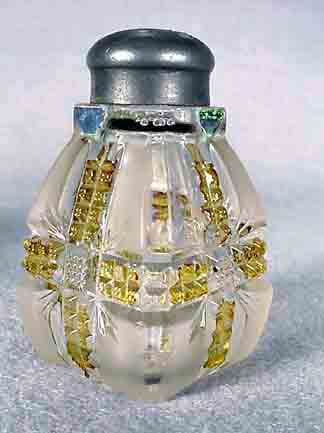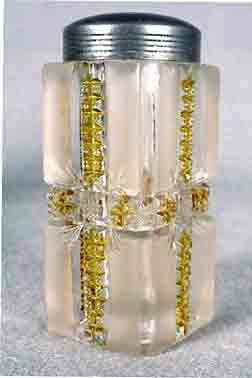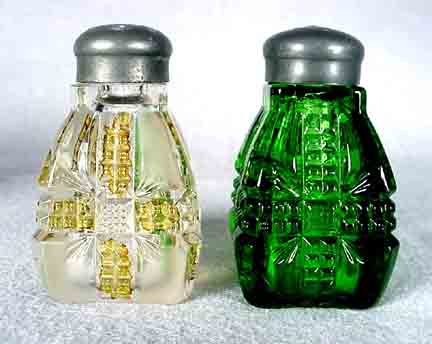Klondike in Emerald Green
Carole & Bob Bruce

One of the thrills of collecting Victorian pattern glass, is the discovery of an unreported color for a known pattern, or the discovery of a piece of a pattern that is unreported. It is hard to believe that this occurs as frequently as it does. Especially when one considers the “Barrels” of the glass that were produced, and to realize that only a few pieces of that color or that pattern piece have survived.

Most collectors of Victorian glassware are well aware of the Klondike pattern. A beautiful pattern, especially when frosted and amber stained. We have seen authors report that it is one of the ten most collectible patterns of all time. As late as mid 1980, one author suggested it may have been one of the top five at that time. While this may or may not be true today, it certainly ranks very high today and very high on the all time list. Two shaker shapes are known. These are shown in the amberette decoration, the shorter version was called Curved Klondike, the taller version was called Oblong Klondike, so named by Peterson in his classic 1968 book on salt shakers. The latter was considered rare at that time.

The pattern was made by Dalzell, Gilmore and Leighton Company of Findlay, Ohio. It was introduced in January 1898 at the Monongahela House. An advertisement appeared in the February issue of China, Glass and Lamps shortly after, calling the pattern “Amberette”. The Klondike name is used today as the Amberette name is used for another pattern and sometimes used generically to identify amber stained patterns. The pattern was introduced in both clear (crystal) and frosted with amber stained.
Kamm stated that the pattern was made by at least three companies. Heacock followed this attribution for a while but later retracted all but the Dalzell attribution. It is interesting to note that Kamm stated she had seen a collection where some pieces had scrolls in lilac on the plain panels. We have never seen nor heard of this decor, but perhaps it may turn up some day. She notes that the Dalzell pieces do not have scrolling, implying that the scroll decorated pieces are not Dalzell. She attributes the pattern to A. J. Beatty & Sons but gives no data or reason for the attribution. She also states it was made by Hobbs, their No. 321 pattern. But Heacock shows catalog reprints which give serious doubts to the Hobbs attribution. The general consensus today seems to be that she was in error on both accounts as there is no evidence that Klondike was made by any company other than Dalzell.
It is interesting to note, especially with the popularity of the pattern today, what Alice Metz had to say about the pattern, circa 1965, “The speculators are buying and selling and there is no sense to the present prices so I am not quoting them. This pattern was made by several firms as late as the 90’s, the shapes are squat and to make it a collector’s item is ridiculous.” She was truly one of the pioneers in glass research and is always fun to read, but we guess you cannot be correct all of the time. We also believe that her comments regarding that the pattern was made by several firms came from Kamm’s comments.

We recently found another piece of Klondike that has not been reported. A Curved Klondike salt shaker was found in emerald green. This was very exciting, as we have never seen another piece of Klondike in any glass color. Tom Bredehoft, noted pattern glassware author and expert, states that in his opinion, emerald green was made after 1898. So, even if evidence surfaces to support another Kamm attribution, this would fix the attribution of the green Klondike shaker to Dalzell, Gilmore and Leighton.
We can find no difference in the molds for the emerald green shaker and the amberette shaker.